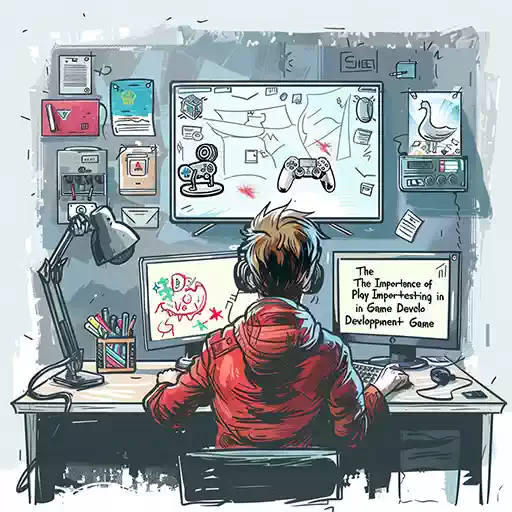The Role of Art and Sound in Creating Immersive Game Worlds
In this article, we’ll take a deep dive into the world of game art and sound design, exploring how these key components work together to create the kind of immersive experiences that keep players coming back for more. We’ll also highlight why these aspects are often just as important as gameplay itself in defining the overall success of a game.

The Power of Visual Art in Games
Imagine booting up a game only to be greeted by dull, uninspired graphics. Not very appealing, right? Visual art is the first thing that catches a player's eye, setting the tone and mood for the entire game. In fact, many gamers decide whether or not they’ll try a new game based purely on its visuals. Whether it's the art style, character design, or the intricacies of the environment, visuals play a huge role in making a game feel alive.1.1 Crafting Unique Art Styles
Every game has a specific art style, and this style is more than just the game’s “look.” It's a reflection of its world, its tone, and its themes. Take games like The Legend of Zelda: Breath of the Wild, which features a vibrant, cel-shaded style that immediately conveys a sense of wonder and exploration. Compare that with a game like Dark Souls, where the dark, gritty, and oppressive visuals are designed to immerse players in a foreboding world of danger and despair.Art style can make or break a game. Players often connect deeply with the visual world of a game, and a unique art style can make the experience unforgettable. Think about games like Cuphead, with its 1930s cartoon art style, or Ori and the Blind Forest, which blends hand-painted artwork with detailed animations. These games stick in your memory long after you’ve put the controller down.
1.2 The Role of Environments in World-Building
The environment in a game is more than just a backdrop; it’s a storytelling tool. Environments can tell players about the game’s lore, set the mood for an encounter, or hint at challenges ahead. In open-world games like The Witcher 3 or Red Dead Redemption 2, the environments are teeming with life, from lush forests to bustling towns. The attention to detail in these environments pulls you into the world, making you feel like you're a part of it rather than just a player.In games like Hollow Knight, for example, the world is built with intricate details that make every location feel like it has its own history. The decayed architecture, gloomy lighting, and haunting colors work together to create an immersive, eerie experience that constantly reminds players they’re in a world on the brink of collapse.
1.3 Character Design: Bringing Personalities to Life
A game’s characters are its heartbeat. Great character design goes beyond how a character looks—it's about their personality, the way they move, and how they fit into the world around them. Characters like Mario or Lara Croft are instantly recognizable, not just because of their iconic appearances, but because their design reflects their personalities and roles in the game.When designing characters, game artists must consider every detail: their costumes, facial expressions, even their posture. All of these elements help bring a character to life, making them feel more like real people—or creatures—instead of just avatars on a screen.

The Magic of Sound Design
While art may catch the eye, sound design is what hooks players on a deeper, more emotional level. Sound has the power to enhance immersion in ways that visuals alone cannot. It can evoke emotions, signal danger, and even guide players through complex environments. Whether it’s the stirring soundtrack in an epic boss fight or the subtle rustling of leaves as you explore a forest, sound design plays an integral role in building a game’s atmosphere.2.1 Music: Setting the Emotional Tone
Music is the soul of a game. It has the ability to elevate simple gameplay moments into unforgettable experiences. Consider the sweeping orchestral scores of The Elder Scrolls series or the haunting piano melodies in The Last of Us. These soundtracks don't just accompany gameplay—they set the emotional tone, immersing players in the game’s narrative and world.A great example of this is Journey, where the music evolves dynamically as you progress, responding to the actions you take and the environment around you. The result? A game that feels like an emotional journey (pun intended), where the music is as much a part of the storytelling as the visuals.
2.2 Sound Effects: Enhancing Player Feedback
From the clang of swords to the crackle of fire, sound effects provide players with immediate feedback, making actions feel more tangible and real. A punch that lands with a satisfying “thud” or the spine-tingling creak of a door opening in a horror game can heighten immersion by reinforcing the physicality of the world. In competitive shooters like Call of Duty, sound cues play a critical role in gameplay, allowing players to hear enemy footsteps or the distant rumble of gunfire.Subtle sound effects also play a significant role in guiding players. In Hollow Knight, for instance, the sound of an enemy faintly buzzing off-screen can alert you to a threat before you see it, building anticipation and tension as you explore.
2.3 Voice Acting: Breathing Life Into Characters
No modern game is complete without voice acting. Well-executed voice performances can elevate a game’s narrative, adding depth and personality to the characters. Think of games like The Witcher 3, where Geralt’s gruff, dry humor is brought to life by Doug Cockle’s voice acting, or the emotionally charged performance of Ashley Johnson as Ellie in The Last of Us.Great voice acting doesn’t just make dialogue feel real—it gives characters a soul. When players can hear the fear, joy, or determination in a character’s voice, it adds a layer of immersion that’s impossible to achieve through visuals alone.

The Perfect Balance: How Art and Sound Work Together
Both art and sound are critical to creating immersive game worlds, but when they come together in perfect harmony, that’s when the magic truly happens. Imagine a battle scene in a game where the visuals are stunning, but the sound doesn’t match the intensity of the action. It would feel off, right? Now imagine a beautifully rendered forest with no ambient sounds like birds chirping or wind rustling through the trees—it would feel hollow, like something is missing.3.1 Visual Cues Enhanced by Sound
In many games, visuals and sound are designed to work in tandem. A visual explosion feels more impactful when it’s accompanied by a booming sound effect. In horror games like Resident Evil, sound often plays a more critical role than visuals in building suspense. The creak of the floorboards or the faint whisper of wind can make a seemingly ordinary environment feel eerie and dangerous, even if nothing appears on screen.3.2 Music and Art Creating Atmosphere
Music can also shape how we interpret the game’s art. A bright, sunny field feels peaceful and serene with the right musical score, but the same environment could feel ominous if paired with a slow, haunting melody. The combination of art and sound works together to immerse players in a particular mood or emotion, deepening their connection to the game world.
Why Art and Sound Matter More Than Ever
As games continue to evolve, the expectations of players grow as well. Gamers today want more than just fun gameplay—they crave fully realized worlds that feel alive. Both art and sound design are essential in meeting these expectations, helping to create more immersive, emotionally resonant experiences that stick with players long after they’ve finished the game.At FOGYX, we understand that these elements are more than just cosmetic—they’re fundamental to the player’s experience. Every sound, every pixel, and every piece of dialogue is carefully crafted to draw players into the world we’ve created and make them feel like they’re part of something bigger.
Conclusion: Art and Sound Are the Heartbeat of Gaming
When it comes to creating immersive game worlds, art and sound aren’t just extras—they are essential components that bring a game to life. The way a world looks, the way it sounds, and the way it feels when you’re interacting with it are all part of what makes gaming such a powerful and unique medium.From crafting detailed environments and characters to designing soundscapes that evoke real emotions, the role of art and sound in game development cannot be understated. They are the heartbeat of gaming, driving immersion and engagement in ways that go beyond just gameplay mechanics.
So the next time you boot up your favorite game, take a moment to appreciate not just how it plays but how it looks and sounds. You’ll likely find that these elements are what truly make the experience unforgettable.
19 December 2024
More articles

As gamers, we’ve all been there—right in the middle of an intense battle or the final moments of a difficult quest, only to experience a sudden lag, a drop in frame rate, or an unresponsive control. It’s frustrating, right? But the good news is, no matter what device you’re gaming on—whether it’s a high-end PC, a console, or a mobile phone—there are ways to optimize your performance and ensure a smooth gaming experience.

In the world of game development, one of the most difficult things to get right is the balance between fun and challenge. Too easy, and players lose interest quickly. Too hard, and they may quit in frustration. Striking that perfect balance is essential, and at FOGYX, it's something we constantly strive for in our games. But how exactly do we make sure our games are both fun and challenging? What goes into finding that sweet spot that keeps players coming back for more? In this article, we’ll break down our approach to balancing fun and challenge in game design, and how these elements come together to create unforgettable gaming experiences.

Creating a video game is an intricate process, requiring more than just creativity and coding skills. To ensure that the final product meets both the developer’s vision and the players’ expectations, one crucial step cannot be overlooked: playtesting. Whether it’s a small indie project or a massive multiplayer title, playtesting is the key to refining gameplay, finding bugs, and making sure everything runs smoothly before a game is released to the public.
all articles
